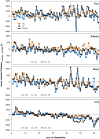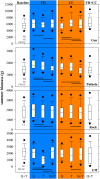Local Variability Mediates Vulnerability of Trout Populations to Land Use and Climate Change
- PMID: 26295478
- PMCID: PMC4546676
- DOI: 10.1371/journal.pone.0135334
Local Variability Mediates Vulnerability of Trout Populations to Land Use and Climate Change
Abstract
Land use and climate change occur simultaneously around the globe. Fully understanding their separate and combined effects requires a mechanistic understanding at the local scale where their effects are ultimately realized. Here we applied an individual-based model of fish population dynamics to evaluate the role of local stream variability in modifying responses of Coastal Cutthroat Trout (Oncorhynchus clarkii clarkii) to scenarios simulating identical changes in temperature and stream flows linked to forest harvest, climate change, and their combined effects over six decades. We parameterized the model for four neighboring streams located in a forested headwater catchment in northwestern Oregon, USA with multi-year, daily measurements of stream temperature, flow, and turbidity (2007-2011), and field measurements of both instream habitat structure and three years of annual trout population estimates. Model simulations revealed that variability in habitat conditions among streams (depth, available habitat) mediated the effects of forest harvest and climate change. Net effects for most simulated trout responses were different from or less than the sum of their separate scenarios. In some cases, forest harvest countered the effects of climate change through increased summer flow. Climate change most strongly influenced trout (earlier fry emergence, reductions in biomass of older trout, increased biomass of young-of-year), but these changes did not consistently translate into reductions in biomass over time. Forest harvest, in contrast, produced fewer and less consistent responses in trout. Earlier fry emergence driven by climate change was the most consistent simulated response, whereas survival, growth, and biomass were inconsistent. Overall our findings indicate a host of local processes can strongly influence how populations respond to broad scale effects of land use and climate change.
Conflict of interest statement
Figures




Similar articles
-
Projected climate-induced habitat loss for salmonids in the John Day River network, Oregon, U.S.A.Conserv Biol. 2012 Oct;26(5):873-82. doi: 10.1111/j.1523-1739.2012.01897.x. Epub 2012 Jul 24. Conserv Biol. 2012. PMID: 22827880
-
Fragmentation and thermal risks from climate change interact to affect persistence of native trout in the Colorado River basin.Glob Chang Biol. 2013 May;19(5):1383-98. doi: 10.1111/gcb.12136. Epub 2013 Mar 4. Glob Chang Biol. 2013. PMID: 23505098
-
Robust estimates of environmental effects on population vital rates: an integrated capture-recapture model of seasonal brook trout growth, survival and movement in a stream network.J Anim Ecol. 2015 Mar;84(2):337-52. doi: 10.1111/1365-2656.12308. Epub 2014 Dec 3. J Anim Ecol. 2015. PMID: 25327608
-
Temperature requirements of Atlantic salmon Salmo salar, brown trout Salmo trutta and Arctic charr Salvelinus alpinus: predicting the effects of climate change.J Fish Biol. 2010 Nov;77(8):1793-817. doi: 10.1111/j.1095-8649.2010.02762.x. Epub 2010 Oct 6. J Fish Biol. 2010. PMID: 21078091 Review.
-
Climate and land-use changes affecting river sediment and brown trout in alpine countries--a review.Environ Sci Pollut Res Int. 2009 Mar;16(2):232-42. doi: 10.1007/s11356-008-0075-3. Epub 2008 Dec 2. Environ Sci Pollut Res Int. 2009. PMID: 19048320 Review.
Cited by
-
Shrinking sizes of trout and salamanders are unexplained by climate warming alone.Sci Rep. 2024 Jun 13;14(1):13614. doi: 10.1038/s41598-024-64145-x. Sci Rep. 2024. PMID: 38871823 Free PMC article.
-
Fish taxonomic, functional, and phylogenetic diversity and their vulnerabilities in the largest river in southeastern China.Ecol Evol. 2021 Jul 24;11(16):11533-11548. doi: 10.1002/ece3.7945. eCollection 2021 Aug. Ecol Evol. 2021. PMID: 34429938 Free PMC article.
-
Thermal regimes of Rocky Mountain lakes warm with climate change.PLoS One. 2017 Jul 6;12(7):e0179498. doi: 10.1371/journal.pone.0179498. eCollection 2017. PLoS One. 2017. PMID: 28683083 Free PMC article.
-
Longitudinal thermal heterogeneity in rivers and refugia for coldwater species: effects of scale and climate change.Aquat Sci. 2018 Jan 1;80(3):1-15. doi: 10.1007/s00027-017-0557-9. Aquat Sci. 2018. PMID: 29556118 Free PMC article.
-
Individual Based Modelling of Fish Migration in a 2-D River System: Model Description and Case Study.Landsc Ecol. 2019 Apr 1;34(4):737-754. doi: 10.1007/s10980-019-00804-z. Landsc Ecol. 2019. PMID: 33424124 Free PMC article.
References
-
- Jarema SI, Samsom S, McGill I, Humphries MM (2009) Variation in abundance across a species' range predicts climate change responses in the range interior will exceed those at the edge: a case study with North American beaver. Global Change Biology, 15, 508–522.
-
- Winkel W, Hudde H (1997) Long-term trends in reproductive traits of tits (Parus major, P. caeruleus) and Pied Flycatchers (Ficedula hypoleuca). Journal of Avian Biology, 28, 187–190.
Publication types
MeSH terms
LinkOut - more resources
Full Text Sources
Other Literature Sources
Medical

